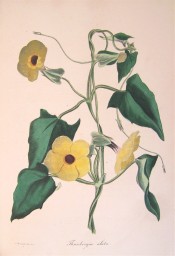Thunbergia alata Bojer ex Sims
Frost tender, evergreen, perennial, twining climber, often grown as an annual, with bright orange or yellow flowers with black centres from summer to autumn. A number of garden cultivars are available in a range of colours, sometimes without the dark centre. Readily self-seeds. To 2.5m. [RHSE, Hortus].
Horticultural & Botanical History
First botanically described in Curtis’s Botanical Magazine in 1825: ‘Our friend Robert Barclay, Esq. who kindly communicated the plant from which our drawing was taken, received the seeds from the Mauritius, through Mr. Telfair, marked Thunbergia alata of Bojer, and stated to be a native of the islands of Zanzebar [sic] and Pomba, on the East coast of Africa. We do not know that any description of Thunbergia alata has been published, but the name under which the seeds were received, given it by Mr. Bojer, a German botanist, appears to us very appropriate. We are informed by Mr David Cameron, the head gardener at Bury hill, that the seeds were sown last February, and the plant flowered in the stove, at Bury Hill, in the following June; it has probably, therefore, not a long abiding root. But its extraordinary beaty makes it a valuable acquisition to the stove.’ [BM t.2591/1825].
‘The flowers are extremely beautiful; they are continued for a long time during the summer and autumn. The strong contrast between the intensely dark colour of the inside of the tube, and the delicate yellow of the border, distinguish them at once from every thing we have seen.’ [LBC no.1045, 1825].
‘This beautiful plant is a native of the island of Zanzebar, in the East Indies, whence seeds were received by the late Mr. Barclay, of Bury Hill, in 1823, and in whose splendid collection it flowered for the first time in this country. It is a stove climbing plant, where it grows and flowers with the greatest luxuriance, a single plant covering a space of four feet by ten feet high, and when in full bloom it makes a gay appearance, the dark purple visible at the mouth of the tube, forming so conspicuous a contrast with the delicate buff colour of the expanded limb of the corolla.’ [MB p.2/1835].
The variety Doddsii, with white-margined leaves, was figured in Flore des Serres. [FS f.413, 1848]. FC p.73/1836.
History at Camden Park
Listed in all published catalogues. [H.222/1843]. The first introduction may have failed as Macarthur included Thunbergia alata among desiderata to Loddiges, 6th January 1845 [MP A2933-2, p.28]. He also requested T. alata, alata alba and aurantica from J. Abbott of Hobart on 16th June 1846 [MP A2933-2, p.159].
Notes
Naturalised in eastern Australia, particularly from Sydney northwards [FNSW]. Also naturalised in the vicinity of Camden Park along the Nepean River.
Published Oct 15, 2009 - 05:09 PM | Last updated May 02, 2011 - 09:38 AM
| Family | Acanthaceae |
|---|---|
| Category | |
| Region of origin | Tropical Africa |
| Synonyms |
|
| Common Name | Black-eyed Susan |
| Name in the Camden Park Record | Thunbergia alata |
| Confidence level | high |
